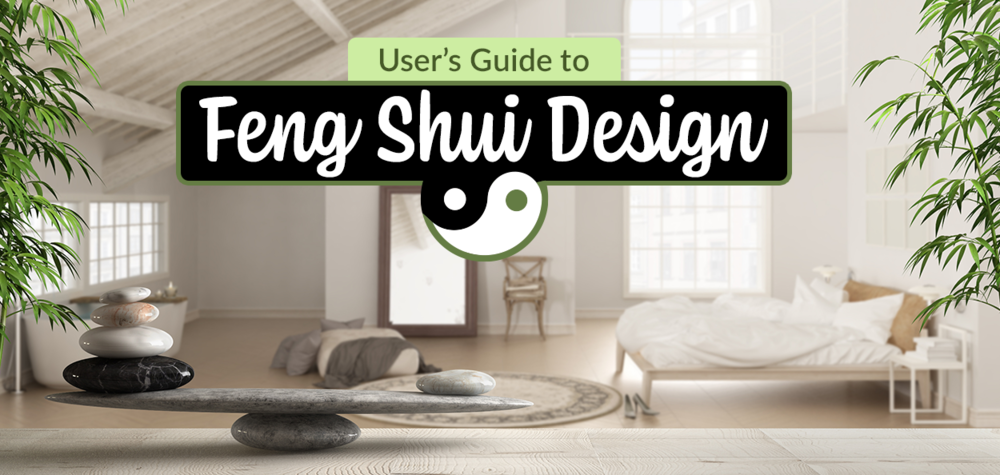There are many ways to cultivate a happy household, one of them being an ancient practice called Feng Shui. If you’re looking to refresh your home and improve the energy within it, follow this guide to discover more about Feng Shui design, its principles, and tips for creating a harmonious household.
What is Feng Shui?
Feng Shui or “wind water” is an ancient Chinese philosophy that aims to strike a balance between elements and optimize the “Chi” or energy. The primary goal of Feng Shui is to create a positive energy flow that nurtures your physical and mental health, success, and relationships.
While this ancient philosophy can be practiced in many ways, it is most commonly used in interior design because the Feng Shui analysis can be easily applied to the home.
Five Feng Shui Elements
Now that you know what Feng Shui is and its ultimate goal, take a look at the five elements that drive Feng Shui design and how you can incorporate them into your home.
1. Wood
The first element is wood, which symbolizes growth and vitality. To put this element into practice, place wood items, such as plants, furniture, and wooden art pieces, in your house to encourage personal growth.
2. Metal
Next up on the elements list is metal, which symbolizes logic and intelligence. To support your knowledge and mental sharpness, add this element to your space with metal decor pieces like light fixtures, tables, frames, and sculptures.
3. Earth
Earth is the third element that makes up Feng Shui design and it represents stability and balance. You can encourage these qualities by decorating your home with rocks, crystals, and landscape imagery like paintings and photographs.
4. Water
The fourth element is water, which symbolizes wisdom and serenity. Incorporating water into your home helps you find clarity and relaxation. Mirrors, reflective surfaces, and aquariums are the best items to use for this element.
5. Fire
Fire is the last Feng Shui design element and it represents passion, energy, transformation, and expansion. Use candles and red objects to bring the fire element inside your home.

The Bagua Map
Before you start implementing Feng Shui design, it helps to understand the Bagua map. The Bagua map analyzes energy in a given space and suggests which elements to bring into the space to enhance the flow or Chi. The map breaks down nine quadrants, or areas, of your home. Each quadrant has an element and color associated with it, which can help you choose your decor.
There is a traditional version of the Bagua map that uses compass directions for navigation and there’s a western interpretation of the map that is simply divided up into categorized squares. The map above combines both traditional and western elements to make it easier for you to interpret. Here is a breakdown of the nine quadrants and the Feng Shui rules that accompany them.
North
The northern quadrant of your home represents your career and life path, which is guided by the water element. For this quadrant, decorate with mirrors and crystals. Dark colors like black are also helpful for the energy flow in this space. Make sure to avoid earth items, piles of paper, and bright colors.
Northeast
The northeast quadrant of your home symbolizes spiritual growth, education, and knowledge. It is guided by the small earth element and best decorated with books, meditation items, and mountain imagery. Try to avoid alcohol and distracting objects in this space.
East
The eastern quadrant represents health and family and is guided by the wood element. Follow Feng Shui rules by nurturing this space with family heirloom items, floral prints, and light colors. Keep the energy flow pure by avoiding metal items in this part of your home.
Southeast
The southeast quadrant symbolizes wealth and prosperity and should remind you to be grateful for what you have. This part of your home is guided by the wood element and should be filled with valuable items, live plants, and artwork of people and places. Avoid trash cans, bills, bathrooms, and toilets in this area of the house.
South
The southern quadrant represents fame and recognition and is guided by the passionate fire element. This area of your home should highlight who you are as a person and who you wish to become. Tall, vertical, and red decor should be placed within this space. Anything that represents your achievements like diplomas and awards also enhance energy flow here. Follow Feng Shui rules by leaving out water items, heavy objects, and dark colors.

Southwest
The southwest quadrant symbolizes love and marriage and is guided by the big earth element. Invite love and sensuality into this part of your house by decorating with candles, photos of you and your partner, and paired objects. Steer clear of sharp items, broken objects, and family photos.
West
The western quadrant represents creativity and children and is guided by the metal element. This space is meant to awaken your inner child, as well as improve the relationships between you and your children. Fill this area with games, toys, circular items, and earth items. Stay away from fire items, sharp objects, and items that block walkways.
Northwest
The northwest quadrant symbolizes helpful people and is centered around valuing those that support you. Guided by the metal element, this quadrant should be decorated with round objects, tools for sorting, and black and white colors. According to Feng Shui rules, this area needs to be void of clutter, storage items, and objects representing compromise.
Feng Shui Tips for the Home
Once you master the five elements and the Bagua map, you are well on your way to becoming a Feng Shui design expert. As you begin organizing your home and incorporating new decor, consider these additional Feng Shui tips to further enhance the Chi in each room.
Add Plants
Plants are representative of the wood element, which is why you should definitely have at least a couple in your house — in the corresponding quadrants, of course. They help to purify the air and bring freshness and vitality.
Prioritize Your Entryway
The entryway of a home is key within Feng Shui design. It represents the way energy enters not only your home, but your life too. Make it as welcoming as possible by keeping it neat and tidy. Personalize with decor items and try your best to include storage pieces like shoe racks, coat hooks, and bins for rain gear, so that each item has its own home.

Clear Clutter
A clean, clutter-free home is one of the most important aspects within the Feng Shui guide. Make sure to regularly clean all surfaces and cleanse the air with essential oils or candles. This helps bring clarity and harmony to the space.
Check Commanding Positions
Commanding position is yet another important principle of Feng Shui design and should be followed in every room of your home. To set up the command position in any space, place the main piece of furniture — a couch, desk, or bed — where you can see the door without being in a direct line with it. This Feng Shui rule aims to position you in the best possible place, so that you can deal with whatever comes into your life.
Let In Air and Light
Air is a crucial component of Feng Shui. After all, “Feng” means wind. You need to make sure your home gets proper air flow and natural light as this combination brings positive energy and rejuvenation.
While there are many more principles and rules within Feng Shui design, this guide provides a solid foundation for you to start enhancing the Chi within your home! As you begin tidying up your space to purify the energy flow, check out these living room layout ideas to make any space feel cozy.


